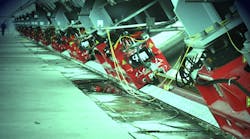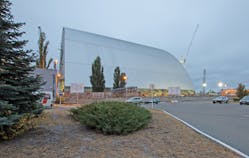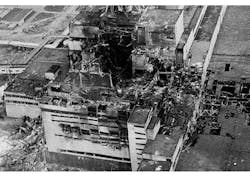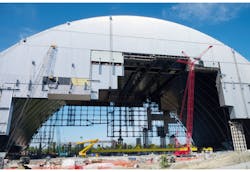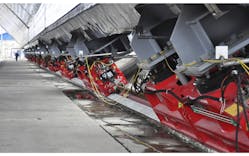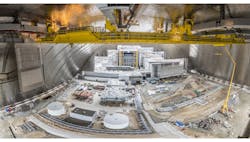The world is always tetering on the brink of complete disaster. We just don’t think about as much as we should.
The 1986 Chernobyl Nuclear Power Plant accident near Pripyat, Ukraine (then part of the former Soviet Union) was an unprecedented disaster on a global scale. Following two explosions at the plant’s No. 4 reactor, radioactive elements (including Iodine-131 and caesium-137)—along with noble gasses, like krypton and xenon—rocketed into the atmosphere like a jet engine.
The first explosion tore off the reactor’s 2,000-ton upper plate and shot it through the roof of the facility, rupturing fuel channels and severing most of the coolant lines that helped keep the reactor from overheating. The second explosion occurred several seconds after the first, destroying the core and everything around it, and sending radioactive debris (including graphite) everywhere in the local vicinity.
While the second explosion effectively terminated the nuclear chain reaction, the intensely hot material of what was left of the core caught fire when it became exposed to air. This contributed greatly to the nuclear fallout that wreaked havoc across Russia and Europe. In a hasty effort to put out the nuclear fire, contain the fallout, and prevent it from spreading, the Russian government tasked hundreds of thousands of military and civilian personnel (known as Liquidators), some of whom gave their lives to help save others.
The Liquidators ultimately filled the exposed core with sand, boric acid, and lead to cool it and keep it from further contaminating the area, after which it was then contained by a concrete “sarcophagus” to prevent rain and snow from reaching the core and setting off another explosion. However, the newly built structure was a stopgap solution meant to contain the radioactive debris for only 20 years. Another solution would be needed before the structure crumbled.
Fast forward to 1992. Realizing the need for a replacement, the Ukrainian government held an international competition for new designs to replace the aging sarcophagus. Out of 394 entries, the contract was ultimately given to France’s Vinci Construction and the industrial group Bouygues. The ingenious arch design they proposed was aimed at containing the entire facility.
Enter the New Safe Containment Project
Construction of the New Safe Containment (NSC) officially began in 2010. It was designed to contain radiation and debris from once again entering the environment due to the crumbling of the aging concrete structure. The design resembles a massive aircraft hangar that’s split into two halves—the reason being, it will be easier to move into place when it’s completed. “Move” being the key word, as construction took place off-site about 300 meters away due to the radiation hazard. To put that into perspective, Liquidators were allowed only 40 sec. of exposure when working on or near (several meters) the damaged reactor before needing to evacuate to a safer distance.
The arch was constructed from the top down. The steel tube framing is assembled on the ground with new sections added, as it’s lifted by massive jacks that can support its total weight (36,000 tons). Each section is sandwiched by triple-layered stainless steel panels that have been coated with polycarbonate material to resist radiation and protect against the elements and corrosion. Because of the erratic blowout damage to reactor No. 4, the structure was not symmetrical. Consequently, articulating slats (or doors) were built into the backside of the structure in order to move the new arch into place and provide a hermetic seal to contain the contamination.
The NSC arch was built on concrete tracks that extend all the way to the reactor, which was used to move the structure into place using a marvel solution designed by talented engineers. On the track itself is a steel railing system that features Teflon-coated panels positioned on both sides, making it easy for a series of push/pull machines to move the arch into place. Each side of the structure uses computer-monitored lasers to make sure they maintain an even, precise forward motion to eliminate the possibility of contortion, which could damage the structure.
Once the arch reached its final position covering the original sarcophagus, the outer door flaps were lowered, and the entire structure was sealed to prevent any radioactive material from escaping. But the job didn’t end there, as the entire structure acts as a gantry for an internal robotic crane designed to remove the radioactive contaminants.
The crane (designed by PaR Systems) features a massive robotic arm that can pick up the debris and drop into special containers that prevent any radiation from escaping. Once loaded, they will then travel down a railing system to an area with storage modules, where they will remain until a permanent site can be found to store the material.
As with any large structure, the 110-meter-tall, 260-meter-wide, and 165-meter-long arch can produce its own atmosphere, which is a problem when it comes to radioactive material—in this case, the possibility of another steam explosion. To prevent this from happening, an environmental conditioning system was installed to circulate dry, temperate air throughout the facility, even through the sandwiched stainless steel panels.
While the new structure is in place, work is still ongoing: The crane system needs to be calibrated and tested, the debris removal platform still requires installation, and a host of other punch-list items still need attending. That being said, the new structure is designed to last a century, giving us more time to find a permanent solution to the ever-present Chernobyl problem.
Mind you, one may never come, but at least we have the breathing room now to explore all options.
